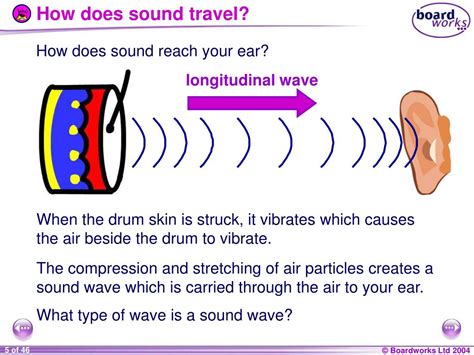5 Ways Sound Travels

Introduction to Sound Travel
Sound is a form of energy that is produced by vibrations. When an object vibrates, it creates a disturbance in the air particles around it, which then carries the energy outward in all directions. This disturbance, or wave, is what we perceive as sound. The way sound travels is fascinating and can be understood through various mediums and mechanisms. In this article, we will explore the different ways sound travels, highlighting the principles behind each method and the factors that influence the speed and quality of sound transmission.
Mediums of Sound Travel
Sound can travel through different mediums, including solids, liquids, and gases. The medium through which sound travels affects its speed, with sound moving faster in solids, then liquids, and slowest in gases. Understanding these mediums is crucial for grasping how sound propagation varies in different environments.
Ways Sound Travels
There are several key ways sound travels, each with its unique characteristics and applications. Let’s delve into the specifics of each method:
Through the Air (Gases): This is the most common method by which we perceive sound. When an object vibrates, it pushes and pulls the air molecules around it, creating compressions and rarefactions (expansions). These disturbances travel through the air as pressure waves until they reach our ears, where they are interpreted as sound. The speed of sound in air is approximately 343 meters per second at sea level and room temperature.
Through Solids: Sound travels faster and more efficiently through solids than through gases. This is because the molecules in a solid are closer together, allowing the energy to transfer more quickly. For example, if you put your ear on a railroad track, you can hear a train coming from much farther away than if you were just listening through the air. This principle is also why solid objects can conduct sound, like a bell or a guitar string.
Through Liquids: Sound travels through liquids, such as water, at a speed that is faster than in gases but slower than in solids. This property is utilized in sonar technology, where sound waves are used to navigate and communicate underwater. The speed of sound in seawater is about 1,482 meters per second, significantly faster than in air.
Through the Ground: Similar to solids, sound can travel through the ground, a phenomenon known as seismic transmission. This method is crucial for seismology, the study of earthquakes, where seismic waves generated by earthquakes are used to understand the Earth’s internal structure. There are two main types of seismic waves: body waves, which travel through the Earth’s interior, and surface waves, which travel along the Earth’s surface.
Through Other Materials: Besides the primary mediums, sound can also travel through other materials like metals, woods, and plastics, each with its own speed of sound. The efficiency of sound travel through these materials depends on their density and elasticity. For instance, sound travels quickly through metals due to their high density and rigidity but more slowly through materials like wood or plastic.
Factors Influencing Sound Travel
Several factors can influence how sound travels, including: - Temperature: The speed of sound in air increases as temperature increases. - Humidity: Changes in humidity can affect the speed of sound in air, though the effect is minimal. - Pressure: Increases in pressure can increase the speed of sound in gases. - Medium Properties: The density and elasticity of a medium significantly affect the speed of sound through it.
| Medium | Speed of Sound (m/s) |
|---|---|
| Air (at sea level and room temperature) | 343 |
| Water | 1,482 |
| Steel | 5,960 |
Applications of Sound Travel
Understanding how sound travels has numerous practical applications across various fields, including: - Acoustics and Audio Engineering: For designing better concert halls, recording studios, and audio equipment. - Medical Imaging: Techniques like ultrasound rely on the principle of sound traveling through the body to create images of internal structures. - Geophysical Exploration: Seismic surveys are used to explore for oil and gas, and to study the Earth’s structure. - Communication: Underwater and through solid objects, as in the case of using the ground or water as a medium for communication.
📝 Note: The speed of sound can be affected by the properties of the medium it is traveling through, making understanding these principles crucial for various applications.
As we conclude our exploration of how sound travels, it’s clear that the mechanisms by which sound propagates are complex and multifaceted. From the air we breathe to the solid ground beneath our feet, sound’s ability to travel through different mediums and its applications in various fields make it a fascinating subject of study. By grasping these principles, we can better appreciate the intricacies of sound and its importance in our daily lives.
What is the fastest medium for sound travel?
+
Sound travels fastest through solids, due to the close proximity of molecules which allows for quicker energy transfer.
How does temperature affect the speed of sound in air?
+
The speed of sound in air increases as the temperature increases. For every degree Celsius the temperature rises, the speed of sound in air increases by approximately 0.6 meters per second.
What are some practical applications of understanding sound travel?
+
Practical applications include acoustics and audio engineering, medical imaging techniques like ultrasound, geophysical exploration, and communication through different mediums.